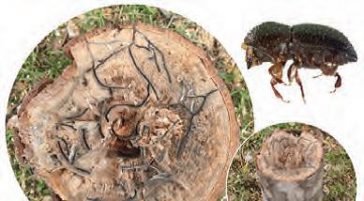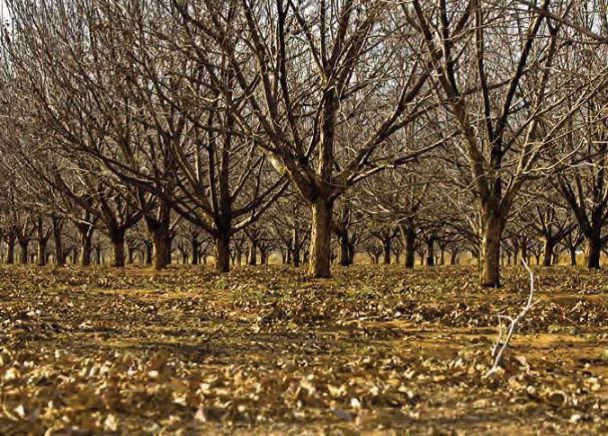180 years. That is for how long a pecan nut tree can yield its rich annual nut crop. With an expected productive life that long, today’s investment for the future of your children and children’s children deserves to be given the best possible sendoff.
Hardus du Toit, senior technical officer of SAPPA (the South African Pecan Nut Association) explained at the TAU Central Region’s “Landboukorrels” Farmers’ Day how important it is to prune pecan nut trees. “It makes no sense planting a pecan nut tree and then just forget about it if you expect it to deliver a good yield,” says Hardus. “The biggest danger is that heavy branches may break, leaving sever lesions. Very big and heavy trees may even break directly below the graft. This can destroy the whole tree.”
Advantages of pruning:
- Limits damage by breakages;
- Pecan nut trees grow old and big and requires a strong structure to cope with the weight of the a big crop;
- Allows ease of movement in grove; Agitator should be able to come close to the trees and big harvesting machines should be able to pass between them;
- Weed control: Enough space is required for equipment and people to do the work with machines or spray equipment;
- Enough space needed for fertilising and mulching;
- Efficient water distribution is imperative. Low hanging branches limits effective irrigation by spraying nozzles;
- High enough frame branches limit damage to trees and moving equipment;
- Effective leaf spraying can only succeed if the spray can reach the target;
- It may be necessary to limit tree height to make cultivation easier. If the rows are 10 metres wide, the trees should not be higher than 10 metres;
- Proper tree shaping results in improved production. Preparation of branch distribution should start early and is an ongoing action with winter pruning, summer pruning and manipulation of budding to influence the angle at which branches grow;
- Next to sunlight, water management is the most important factor for growth and production. Sunlight should reach leaves for photosynthesis, especially from the 10th year onwards; and
- Should trees become too big, some may be thinned out to create more space or branches thinned. This can promote regeneration in the tree and stimulate the nut crop.
Hennie du Plessis of Lowveld Agrochem stressed the importance of zinc in pecan nut production. He says South African soils suffer from a wide general zinc deficiency and it is important for pecan nut producers to draw up a practical preventive zinc application program. “By the time one begins to see the signs of a zinc deficit, it is already six months to a year too late.”
- Hardus du Toit.
- Hennie du Plessis.
Zink (Zn) was discovered in 1746. It is the 24th most abundant element and is essential for humans, plants and animals. It is the precursor of amino acids and hormones which is responsible for cell enlargement, growth and development.
How to identify a zinc deficit
Leaf analysis is the only method of quantifying zinc deficit. The norm is between 50-100 mg/kg. Below 50 mg/kg is regarded as a zinc deficit. Visual symptoms will mainly be prominent on new growth. The new leaves will be narrow with wavy edges and yellowing between the veins. The lighter the colour between the veins, the lower the zinc content. Leaf thickness will also suffer and secondary damage, such as disease, insect damage and sunburn will increase. By the time visual zinc deficit can be seen the yield is already adversely affected.
Rectifying action
Leaf spraying can be effective to increase a low level quickly. However, there are various factors that may influence the effectivity such as growth phase, leaf water content, temperature, light intensity, time of day, humidity, wind and accessibility of the leaves.
Where there is a zinc deficit in the soil, correction through soil application is a long term solution. There are factors that can influence the success of this route such as chemical and physical soil characteristics. Soil pH has a major influence on the availability of zinc to the tree – the higher the pH, the less available the zinc will be.
That is why soil correction will only be successful once the soil’s pH has been corrected. Annual leaf analysis, as well as soil analysis every third year, is the best method to deal with a zinc crisis in pecan nut groves.
Factors that may influence the success of the application, such as chemical and physical soil characteristics, also apply here, and especially the pH. The higher the pH, the less available the zinc will be. Regular soil analysis remains the best method of planning preventive action.
Francois van Greunen of Syngenta also stressed preventive action regarding diseases and pests. He said a disease management program will vary from region to region and growers should work in tandem with local experts. It is wise to apply a broad spectrum fungicide immediately after winter and systemic agents later in the season so that it can reach the leaves.

Thea Ferreira.
Thea Ferreira of Syngenta showed the farmers all the insects responsible for damage. The green stinkbug tops the list. It is important that insecticides sprayed against this pest should reach the top layer of leaves – that is where the bug is most plentiful. The green citrus leafhopper attacks young leaves and nuts, and be on the lookout for aphids for the secondary damage they can do. The pecan snout beetle can damage nuts and the pecan trunk borer appears sporadically.
A major new danger is the Polyphagous shothole borer (it is still too new to have an Afrikaans name). This beetle has already spread widely. It is a mere 1,5 to 1,6 mm long, but its onslaught takes place by means of a fungus. The beetle is a carrier of the fusarium fungus. A farmer will know his trees are invested if it looks as if the bole has been shot with buckshot.
SAPPA is presently engaged in a research project and requests that anyone observing this beetle and its fungus should report it. (Visit: http://polyphagous-shot-hole-borer.co.za/ for more information and to see what it looks like.
Thea says the good news is that Syngenta is working on an insecticide that can control the pest. The application for registration of the insecticide still has to be approved before they can market it as a solution.

Polyphagous shothole borer
A well-known pecan nut farmer from Cullinan, Albert Bouwmeester, told attendees that there had been a dramatic increase in pecan nut production in South Africa. With new orchards coming into production now, the crop should double by 2021. Luckily there is still a global shortage. Another advantage is that South African pecan nuts are market-ready five months before that of America. This means that SA nuts is available for the important Chinese new year festival at the end of January.
For more information regarding the TLU SA Landboukorrels Boeredag, contact Lynette du Plessis on 012-804-8031; email: sentraal@tlu.co.za, or visit www.tlu.co.za .











